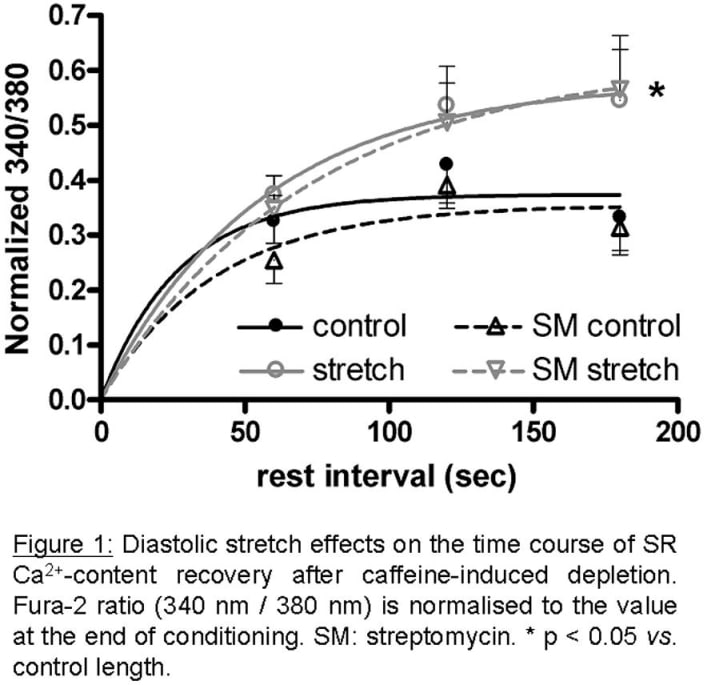Effects of mechanical stimulation on cardiomyocyte sarcoplasmic reticulum (SR) Ca2+ handling are not well understood. Here, we investigate how diastolic stretch affects reloading of the Ca2+-depleted SR in Guinea pig isolated ventricular myocytes.Guinea pigs were killed by cervical dislocation, hearts were quickly excised, and cells were isolated using established Langendorff perfusion-based protocols [1]. Isolated cardiomyocytes were Fura-2AM loaded (1.25 µM, 6 min), and carbon fibres were attached to apply axial stretch. Cardiomyocytes were conditioned by field-stimulation at 2 Hz (all experiments at 37 °C), while Fura-2 fluorescence ratio and sarcomere length were simultaneously recorded (IonOptix). After reaching a steady state, stimulation was interrupted while cells were rapidly subjected to superfusion with 10 mM caffeine (Cell MicroControls solution switch). Caffeine was initially (1 s) applied in Na/Ca-free solution (to estimate SR content), and then (1 s) in normal Tyrode solution (to deplete the SR). Reuptake of Ca2+ into the SR of quiescent cells was assessed after varying intervals of perfusion with caffeine-free normal Tyrode (for 5 to 120 s) by re-exposure to 10 mM caffeine in Na/Ca-free solution. During the interval between caffeine applications, cells were either held at resting sarcomere length, or stretched by 5%, both in the presence and absence of streptomycin (40 µM) to block stretch-activated ion channels [2]. All procedures conform with UK Home Office regulations.The post-rest caffeine-induced Ca2+ signal became larger as the rest interval increased. Fig.1 shows Diastolic stretch increases SR Ca2+ content recovery (significant at all time > 30 s) Additional action potential clamp experiments confirmed that streptomycin (40 µM, n = 5) does indeed cause complete abolition of stretch-induced compensation currents, confirming its blocking effect on stretch-activated currents in this cell population.Thus, diastolic reloading of the Ca2+-depleted SR of Guinea pig ventricular myocytes is enhanced by axial stretch, and underlying mechanisms are streptomycin-independent.
University of Glasgow (2004) J Physiol 557P, PC13
Communications: Diastolic stretch enhances reloading of the Ca2+-depleted sarcoplasmic reticulum in Guinea pig ventricular myocytes via a streptomycin-independent pathway
G. Iribe, P.J. Cooper, M. Lei and P. Kohl
University Lab of Physiology, Oxford, UK
View other abstracts by:
Where applicable, experiments conform with Society ethical requirements.

